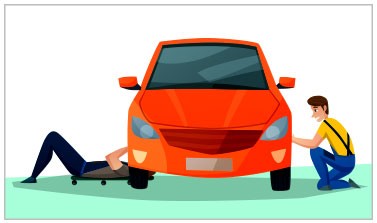
Timing Belt Replacement
The timing belt is a critical part of your car engine. It keeps the engine's movements synchronized and generates energy so your car will keep moving forward.
However, nothing lasts forever, and despite proper maintenance, it will eventually need replacement at some point in time.
What is a Timing Belt?
The timing belt is a thick rubber belt located inside your engine. It comes with rugged, groove-like teeth that latch onto cogs on the crankshaft and camshaft, so they are aligned and synchronized.
The term “timing belt" came about from its primary function, which is to time the opening and closing of the engine's intake and exhaust valves with the up and down movement of the engine pistons for a smooth working engine. If any parts break the timing or unison of their movements, the engine will have issues, and the vehicle will no longer work.
The term “timing belt" came about from its primary function, which is to time the opening and closing of the engine's intake and exhaust valves with the up and down movement of the engine pistons for a smooth working engine. If any parts break the timing or unison of their movements, the engine will have issues, and the vehicle will no longer work.
How often should I replace my timing belt?
Because the timing belt plays such a significant role, it must be replaced on a regular basis. Most manufacturers suggest changing your vehicle's timing belt upon reaching 100,000 kilometres or 7 to 10 years.
Eight signs that your timing belt needs replacement
You can find information on how long your car’s timing belt will last in your owner's manual. However, here are eight signs where you'll need a replacement even before what is indicated by your car manufacturer:
1. Your engine is losing power.
2. Your engine overheats prematurely.
3. Vibrating or shaking vehicle.
4. Difficulty starting the engine.
5. You hear a rubbing or squealing noise from your engine.
6. Oil leaks.
7. A smoking engine.
8. Check that the engine light turns on or starts flashing.
What is the procedure for replacing your timing belt?
Remove grounding cable from your battery and all other parts that may get in the way of removing the timing belt.
Open and remove the timing belt cover, turn the crankshaft and loosen the tensioner pulley before removing your timing belt.
Pull your idler and belt pulleys back into place and replace other parts if necessary.
Align your new belt as you carefully move the adjusting screw into its final position.
Rotate your crankshaft until it makes one complete revolution to ensure that the timing belt has the right amount of tension.
Recheck the alignment for the last time, tighten your screws and refit all engine parts.
Reground your battery and start the engine.
Remove grounding cable from your battery and all other parts that may get in the way of removing the timing belt.
Open and remove the timing belt cover, turn the crankshaft and loosen the tensioner pulley before removing your timing belt.
Pull your idler and belt pulleys back into place and replace other parts if necessary.
Align your new belt as you carefully move the adjusting screw into its final position.
Rotate your crankshaft until it makes one complete revolution to ensure that the timing belt has the right amount of tension.
Recheck the alignment for the last time, tighten your screws and refit all engine parts.
Reground your battery and start the engine.
Timing Belt Replacement near me
Need your timing belt replaced right now? Get a quote from one of our partner auto-repair centres to ensure your engine's many rotating parts are in complete sync and working smoothly.
The Tyroola Advantage
We work with only the best professional mechanics to get your car roadworthy!
Book the best mechanics
Tyroola has over 500 partner auto care centres all over Australia. You'll only get the best.
Repair Now & Pay Later
With interest free payments so safety won't have to wait.
No hidden prices
No car repair bill shock! You'll know how much it will cost before any work is started.




